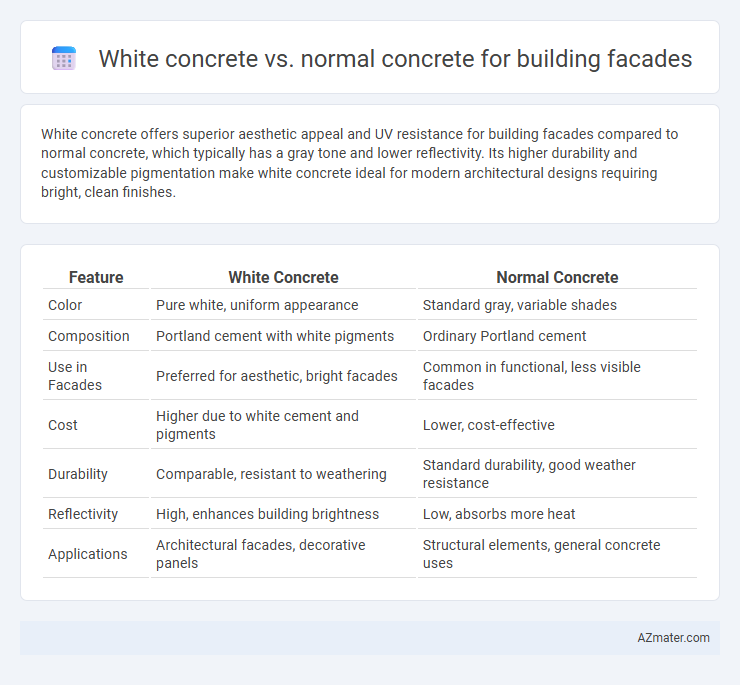White concrete offers superior aesthetic appeal and UV resistance for building facades compared to normal concrete, which typically has a gray tone and lower reflectivity. Its higher durability and customizable pigmentation make white concrete ideal for modern architectural designs requiring bright, clean finishes.
Table of Comparison
| Feature | White Concrete | Normal Concrete |
|---|---|---|
| Color | Pure white, uniform appearance | Standard gray, variable shades |
| Composition | Portland cement with white pigments | Ordinary Portland cement |
| Use in Facades | Preferred for aesthetic, bright facades | Common in functional, less visible facades |
| Cost | Higher due to white cement and pigments | Lower, cost-effective |
| Durability | Comparable, resistant to weathering | Standard durability, good weather resistance |
| Reflectivity | High, enhances building brightness | Low, absorbs more heat |
| Applications | Architectural facades, decorative panels | Structural elements, general concrete uses |
Introduction: Understanding White Concrete and Normal Concrete
White concrete is a specialized form of concrete made with white Portland cement and light-colored aggregates, resulting in a bright, aesthetically appealing facade ideal for modern architectural designs. Normal concrete, composed of ordinary Portland cement, typically features gray tones due to the natural color of its ingredients and is widely used for structural purposes without emphasis on appearance. Both materials offer durability and strength, but white concrete provides enhanced visual appeal and customization options for building facades.
Composition Differences Between White and Normal Concrete
White concrete uses white cement and light-colored aggregates such as quartz or marble to achieve its distinct color, while normal concrete typically contains ordinary gray Portland cement and darker aggregates like crushed stone or gravel. The high purity of raw materials and absence of iron and manganese in white cement minimize discoloration and allow for better pigmentation control in white concrete. Normal concrete's composition focuses on strength and durability without aesthetic color considerations, leading to a more cost-effective but less visually appealing facade finish.
Aesthetic Appeal: Visual Impact on Building Facades
White concrete offers a distinct aesthetic appeal by providing a bright, clean, and uniform surface that enhances the visual impact of building facades compared to normal gray concrete. Its ability to reflect natural light accentuates architectural details and creates a modern, vibrant appearance that stands out in urban environments. White concrete also allows for more versatile color treatments and finishes, giving architects greater creative freedom to achieve unique facade designs.
Durability and Weather Resistance of Facade Materials
White concrete offers enhanced durability and superior weather resistance for building facades due to its refined mix design and lower water-cement ratio, reducing porosity and minimizing surface degradation. Normal concrete, while structurally reliable, is more susceptible to cracking, discoloration, and erosion when exposed to harsh environmental conditions such as UV radiation, moisture, and temperature fluctuations. The optimized composition of white concrete ensures longer-lasting aesthetic appeal and protection against weather-induced damage, making it a preferred choice for exterior cladding applications.
Cost Comparison: White Concrete vs Normal Concrete
White concrete typically costs 20-30% more than normal concrete due to the use of special white cement and higher-quality aggregates, impacting overall facade project budgets. Normal concrete remains more cost-effective for large-scale applications where aesthetic appeal is less critical. The increased cost of white concrete can be justified by its superior visual appeal and reduced need for additional surface treatments on building facades.
Energy Efficiency and Thermal Performance
White concrete for building facades demonstrates superior energy efficiency due to its high solar reflectance, significantly reducing heat absorption compared to normal concrete. This reflective property lowers cooling loads in buildings, enhancing thermal performance and reducing HVAC energy consumption. Studies indicate that white concrete can decrease surface temperatures by up to 40degF (22degC) under direct sunlight, improving occupant comfort and sustainability.
Maintenance Requirements for Each Concrete Type
White concrete requires less frequent cleaning and resists staining better than normal concrete, making it ideal for high-visibility building facades. Normal concrete may demand more regular maintenance, such as power washing and sealing, to prevent discoloration and surface degradation over time. Both types benefit from routine inspections, but white concrete's pigmentation enhances durability against weathering effects and reduces upkeep costs.
Environmental Impact and Sustainability
White concrete, made with white Portland cement and light-colored aggregates, reduces urban heat island effects by reflecting more solar radiation, enhancing building energy efficiency. It typically requires higher-quality raw materials and energy-intensive processing, which can increase its environmental footprint compared to normal concrete made with traditional gray cement and conventional aggregates. Sustainable use of white concrete involves optimizing mix design to minimize cement content and incorporating supplementary cementitious materials to reduce carbon emissions while maintaining aesthetic appeal.
Architectural Flexibility and Design Possibilities
White concrete offers superior architectural flexibility compared to normal concrete due to its ability to achieve a wide spectrum of colors and finishes, enhancing aesthetic appeal on building facades. It enables designers to incorporate vibrant hues and intricate patterns without the need for additional paints or coatings, reducing maintenance costs and durability issues. Normal concrete typically provides limited color options and texture variations, making white concrete the preferred choice for innovative and visually striking facade designs.
Choosing the Right Concrete for Your Building Facade
White concrete offers superior aesthetic appeal with its bright, clean finish, making it ideal for modern building facades where visual impact is crucial. Normal concrete, typically gray, provides reliable strength and durability at a lower cost, suitable for structural elements where appearance is less critical. Selecting the right concrete depends on balancing design requirements, budget constraints, and long-term maintenance considerations for the building facade.

Infographic: White concrete vs Normal concrete for Building facade
 azmater.com
azmater.com